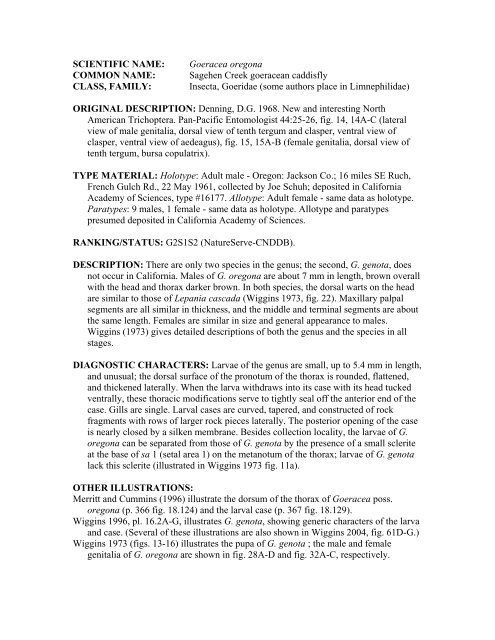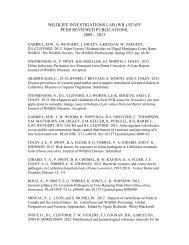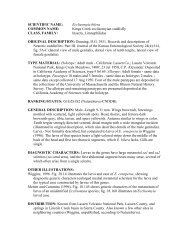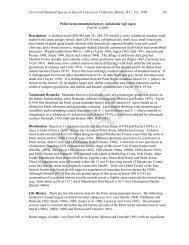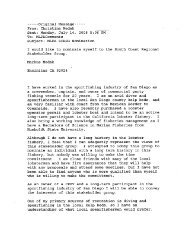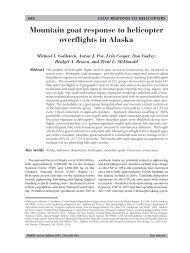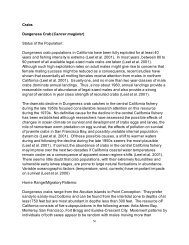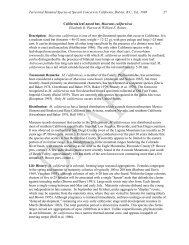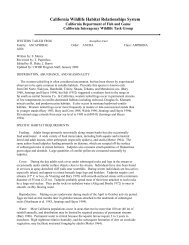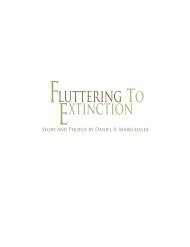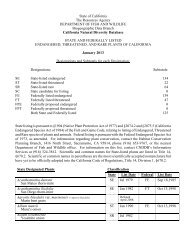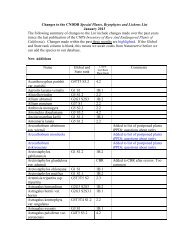Goeracea oregona - California Department of Fish and Game
Goeracea oregona - California Department of Fish and Game
Goeracea oregona - California Department of Fish and Game
You also want an ePaper? Increase the reach of your titles
YUMPU automatically turns print PDFs into web optimized ePapers that Google loves.
SCIENTIFIC NAME: <strong>Goeracea</strong> <strong>oregona</strong><br />
COMMON NAME: Sagehen Creek goeracean caddisfly<br />
CLASS, FAMILY: Insecta, Goeridae (some authors place in Limnephilidae)<br />
ORIGINAL DESCRIPTION: Denning, D.G. 1968. New <strong>and</strong> interesting North<br />
American Trichoptera. Pan-Pacific Entomologist 44:25-26, fig. 14, 14A-C (lateral<br />
view <strong>of</strong> male genitalia, dorsal view <strong>of</strong> tenth tergum <strong>and</strong> clasper, ventral view <strong>of</strong><br />
clasper, ventral view <strong>of</strong> aedeagus), fig. 15, 15A-B (female genitalia, dorsal view <strong>of</strong><br />
tenth tergum, bursa copulatrix).<br />
TYPE MATERIAL: Holotype: Adult male - Oregon: Jackson Co.; 16 miles SE Ruch,<br />
French Gulch Rd., 22 May 1961, collected by Joe Schuh; deposited in <strong>California</strong><br />
Academy <strong>of</strong> Sciences, type #16177. Allotype: Adult female - same data as holotype.<br />
Paratypes: 9 males, 1 female - same data as holotype. Allotype <strong>and</strong> paratypes<br />
presumed deposited in <strong>California</strong> Academy <strong>of</strong> Sciences.<br />
RANKING/STATUS: G2S1S2 (NatureServe-CNDDB).<br />
DESCRIPTION: There are only two species in the genus; the second, G. genota, does<br />
not occur in <strong>California</strong>. Males <strong>of</strong> G. <strong>oregona</strong> are about 7 mm in length, brown overall<br />
with the head <strong>and</strong> thorax darker brown. In both species, the dorsal warts on the head<br />
are similar to those <strong>of</strong> Lepania cascada (Wiggins 1973, fig. 22). Maxillary palpal<br />
segments are all similar in thickness, <strong>and</strong> the middle <strong>and</strong> terminal segments are about<br />
the same length. Females are similar in size <strong>and</strong> general appearance to males.<br />
Wiggins (1973) gives detailed descriptions <strong>of</strong> both the genus <strong>and</strong> the species in all<br />
stages.<br />
DIAGNOSTIC CHARACTERS: Larvae <strong>of</strong> the genus are small, up to 5.4 mm in length,<br />
<strong>and</strong> unusual; the dorsal surface <strong>of</strong> the pronotum <strong>of</strong> the thorax is rounded, flattened,<br />
<strong>and</strong> thickened laterally. When the larva withdraws into its case with its head tucked<br />
ventrally, these thoracic modifications serve to tightly seal <strong>of</strong>f the anterior end <strong>of</strong> the<br />
case. Gills are single. Larval cases are curved, tapered, <strong>and</strong> constructed <strong>of</strong> rock<br />
fragments with rows <strong>of</strong> larger rock pieces laterally. The posterior opening <strong>of</strong> the case<br />
is nearly closed by a silken membrane. Besides collection locality, the larvae <strong>of</strong> G.<br />
<strong>oregona</strong> can be separated from those <strong>of</strong> G. genota by the presence <strong>of</strong> a small sclerite<br />
at the base <strong>of</strong> sa 1 (setal area 1) on the metanotum <strong>of</strong> the thorax; larvae <strong>of</strong> G. genota<br />
lack this sclerite (illustrated in Wiggins 1973 fig. 11a).<br />
OTHER ILLUSTRATIONS:<br />
Merritt <strong>and</strong> Cummins (1996) illustrate the dorsum <strong>of</strong> the thorax <strong>of</strong> <strong>Goeracea</strong> poss.<br />
<strong>oregona</strong> (p. 366 fig. 18.124) <strong>and</strong> the larval case (p. 367 fig. 18.129).<br />
Wiggins 1996, pl. 16.2A-G, illustrates G. genota, showing generic characters <strong>of</strong> the larva<br />
<strong>and</strong> case. (Several <strong>of</strong> these illustrations are also shown in Wiggins 2004, fig. 61D-G.)<br />
Wiggins 1973 (figs. 13-16) illustrates the pupa <strong>of</strong> G. genota ; the male <strong>and</strong> female<br />
genitalia <strong>of</strong> G. <strong>oregona</strong> are shown in fig. 28A-D <strong>and</strong> fig. 32A-C, respectively.
DISTRIBUTION: Originally described from Jackson Co., Oregon, but now known from<br />
several localities in Oregon <strong>and</strong> <strong>California</strong>. Almost all <strong>California</strong> specimens are from<br />
Nevada <strong>and</strong> Sierra Counties, but a penultimate larva from Mount Tampalpias in<br />
Marin County may possibly be this species (Wiggins 1973). Contrary to the common<br />
name, the species is not present in Sagehen Creek.<br />
HABITAT: Relatively warm (9-11 o C) spring sources.<br />
LIFE HISTORY/BEHAVIOR: <strong>Goeracea</strong> <strong>oregona</strong> has a lengthy emergence period,<br />
with adults collected at one location from June to October. The collection <strong>of</strong> several<br />
different life stages in July suggests that this species takes two years to complete its<br />
development. The larvae are usually found on rocks, <strong>and</strong> feed on fine particles <strong>and</strong><br />
vascular plant parts that they scrape with their toothless m<strong>and</strong>ibles. Erman (1998)<br />
observed near-flightless mating behavior for this species <strong>and</strong> noted that while locally<br />
common in benthic samples, it was not abundant in emergence traps.<br />
SELECTED REFERENCES:<br />
Erman, N.A. 1998. Invertebrate richness <strong>and</strong> Trichoptera phenology in Sierra Nevada<br />
(<strong>California</strong>, USA) cold springs: sources <strong>of</strong> variation. Pp. 95-108. In: Studies in<br />
crenobiology: The biology <strong>of</strong> springs <strong>and</strong> springbrooks (Botosaneanu, L., ed.).<br />
Backhuys Publishers, Leiden, The Netherl<strong>and</strong>s.<br />
Erman, N.A. <strong>and</strong> C.D. Nagano. 1992. A review <strong>of</strong> the <strong>California</strong> caddisflies (Trichoptera)<br />
listed as c<strong>and</strong>idate species on the 1989 federal "Endangered <strong>and</strong> threatened wildlife<br />
<strong>and</strong> plants; Animal notice <strong>of</strong> review." <strong>California</strong> <strong>Fish</strong> <strong>and</strong> <strong>Game</strong> 78(2):45-56.<br />
Merritt, R.W. <strong>and</strong> K.W. Cummins. 1996. An Introduction to the Aquatic Insects <strong>of</strong> North<br />
America. Kendall/Hunt Publishing Co., Dubuque. 862 pp.<br />
Wiggins, G.B. 1973. New systematic data for the North American caddisfly genera<br />
Lepania, <strong>Goeracea</strong>, <strong>and</strong> Goerita (Trichoptera: Limnephilidae). Contributions <strong>of</strong> the<br />
Royal Ontario Museum <strong>of</strong> Life Sciences 91:1-33.<br />
Wiggins, G.B. 1996. Larvae <strong>of</strong> the North American caddisfly genera. 2 nd Edition.<br />
University <strong>of</strong> Toronto Press, Toronto. 457 pp.<br />
Wiggins, G.B. 2004. Caddisflies: The Underwater Architects. University <strong>of</strong> Toronto<br />
Press, Toronto, Buffalo, London. 292 pp.<br />
Written by S<strong>and</strong>ra Shanks, <strong>California</strong> <strong>Department</strong> <strong>of</strong> <strong>Fish</strong> <strong>and</strong> <strong>Game</strong>, Natural Diversity<br />
Database


